

Trelstar 注射用醋酸曲普瑞林




| 通用中文 | 注射用醋酸曲普瑞林 | 通用外文 | Triptorelin Acetate For Injection |
| 品牌中文 | 品牌外文 | Trelstar | |
| 其他名称 | Decapeptyl Depot GONAPEPTYL DEPOT | ||
| 公司 | 辉凌制药(Ferring) | 产地 | 德国(Germany) |
| 含量 | 3.75mg | 包装 | 1瓶/盒 |
| 剂型给药 | 粉针剂 | 储存 | 室温 |
| 适用范围 | 前列腺癌 | ||
| 通用中文 | 注射用醋酸曲普瑞林 |
| 通用外文 | Triptorelin Acetate For Injection |
| 品牌中文 | |
| 品牌外文 | Trelstar |
| 其他名称 | Decapeptyl Depot GONAPEPTYL DEPOT |
| 公司 | 辉凌制药(Ferring) |
| 产地 | 德国(Germany) |
| 含量 | 3.75mg |
| 包装 | 1瓶/盒 |
| 剂型给药 | 粉针剂 |
| 储存 | 室温 |
| 适用范围 | 前列腺癌 |
【药品名称】
通用名称:注射用醋酸曲普瑞林
商品名称:达菲林
英文名称:Triptorelin Acetate for Injection
【成份】
主要成份为醋酸曲普瑞林。
【性状】
为白色冻干物或粉末。
【药理作用】
曲普瑞林(Triptorelin)是一合成的十肽,是天然GnRH(促性腺激素释放激素)的类似物。动物研究和人体研究表明,初始刺激后,长期使用曲普瑞林可抑制促性腺激素的分泌,从而抑制睾丸和卵巢的功能。对动物进行的进一步研究提示另一作用机制:通过降低外周GnRH受体的敏感性产生直接性腺抑制作用。前列腺癌:注射曲普瑞林,早期血LH和FSH水平升高,进而血睾酮水平升高;继续用药2~3周,血LH和FSH水平降低,进而血睾酮降至去势水平。同时,治疗初期酸性磷酸酶一过性增高。治疗可使症状有所改善。性早熟:在两性,曲普瑞林均可抑制垂体促性腺激素的分泌亢进,表现为雌二醇或睾酮的分泌的抑制、LH峰值降低以及身高年龄/骨龄比例的提高。最初的性腺刺激有可能引起阴道的少量出血,需要使用醋酸甲羟孕酮或环丙孕酮醋酸酯治疗。子宫内膜异位症:曲普瑞林持续用药可抑制雌二醇的分泌,从而使异位的子宫内膜组织处于休息状态。不孕症:曲普瑞林可抑制促性腺激素(FSH和LH)的分泌。这一治疗确保抑制LH峰值,从而提高卵泡生成的质量,增加卵泡数量。子宫肌瘤:研究表明某些子宫肌瘤的体积明显缩小,在治疗第3个月时最明显。大多数患者在治疗第1个月后出现闭经,需纠正因月经过多或子宫出血造成的贫血。动物毒理研究未显示该药物分子具有任何特殊毒性。观察到的作用与药品对内分泌系统的药理特性有关。用药后40~45天吸收完全。
【药代动力学】
肌内注射缓释剂型后,药物首先经历一个初始释放阶段,随后进入有规律的均匀释放阶段,持续释放28天。药物在注射后一个月内的生物利用度为53%。
【达菲林适应症】
前列腺癌:治疗转移性前列腺癌。对以前未接受过其它激素治疗的患者,药物疗效更明显。
性早熟(女孩8岁以前,男孩10岁以前):生殖器内外的子宫内膜异位症(I至IV期):一个疗程应限制在6个月内。建议不要使用曲普瑞林或其它GnRH类似物进行第二个疗程的治疗。女性不孕症:在体外受精-胚胎移植程序(IVF-ET)中,与促性腺激素(hMG, FSH, hCG)联合使用,诱导排卵。手术前子宫肌瘤的治疗:伴有贫血症(血红蛋白含量≤8g/dl)时;为便于内窥镜手术和经阴道手术需缩小肿瘤大小时疗程限于3个月。
【用法用量】
给药方法和途径:达菲林仅可肌内注射,用药盒内提供的溶剂复溶药物粉末,复溶后立即注射。复溶后得到的悬浮液不得与其它药品混合。
1.前列腺癌:一次1支。每4周注射一次。
2.性早熟:按体重一次50μg/kg,每4周注射一次。
3.子宫内膜异位症:应在月经周期的前5天开始治疗。注射次数:一次1支,每4周注射一次。 疗程:根据发病时严重程度以及治疗过程中临床指标的变化(包括功能和器质性指标)而定。原则上,一个疗程应至少4个月,至多6个月。建议不要使用曲普瑞林或其它GnRH类似物进行第二个疗程的治疗。
4.女性不孕症:在月经周期第2天肌内注射1支。当垂体去敏后(血浆雌激素<50pg/ml),一般在注射达菲林后15天,开始联合使用促性腺激素治疗。
5.手术前子宫肌瘤的治疗:治疗应在月经周期的前5天开始。注射次数:每4周注射一次,每次1支。疗程:3个月。
【不良反应】
男性:治疗初期,随着血睾酮水平一过性升高,部分患者可见尿路症状、骨转移造成骨痛、椎骨转移造成的脊髓压迫等症状加重,1-2周后这些症状会消失治疗过程中,最常报导的不良反应(潮热、性欲下降和阳萎)与血浆睾酮降低有关,这是药品药理作用的结果,与其它GnRH类似物所观察到的不良反应相似。女性:治疗初期,由于血浆雌二醇水平一过性增高,出现子宫内膜异位症症状(骨盆疼痛,痛经)加重,1-2周后消失。第一次注射后一个月内可能出现子宫出血。该药物用于治疗女性不孕症时,联合使用促性腺激素可造成对卵巢刺激,有可能出现卵巢肥大,盆腔疼痛和/或腹痛。治疗过程中,最常报导的不良反应如潮热、阴道干燥、性欲下降,性交困难与垂体-卵巢阻断有关。罕见有头痛、关节痛和肌肉痛的报导。男、女性:报导有过敏反应,如荨麻疹,皮疹,瘙痒。罕见有Quincke水肿(昆克水肿)发生。一些患者出现恶心、呕吐、体重增加、高血压、情绪紊乱、发烧、视觉异常、注射处疼痛。长期使用GnRH类似物可引起骨质流失,有致骨质疏松的危险。儿童:卵巢初始刺激可能导致女孩出现少量阴道出血。如同成人,儿童也有报导出现过敏反应,如荨麻疹,皮疹,瘙痒,罕有Quincke水肿发生。一些患儿出现恶心、呕吐、体重增加、高血压、情绪紊乱、发烧、视觉异常、注射处疼痛。即使治疗收到满意效果时也可能出现以上不良反应。如患者发生以上不良反应或本说明书未列出的不良反应,请立即通知医生。
【禁忌】
对GnRH,GnRH类似物或药品任何一种成分过敏者禁用。
【注意事项】
男性:前列腺癌:治疗开始时,极少数病例有单发的一过性的临床症状加重(尤其是骨痛)。在治疗的最初数周应给予密切的医疗监护,尤其对于那些有尿路梗阻和椎骨转移的患者。同理,对有脊髓压迫症状的患者也应给予密切的医疗监护。治疗初期可观察到酸性磷酸酶一过性增高。有必要定期检查血睾酮水平,不应高于1ng/ml。女性: 在医生给患者开药前,应确认患者没有怀孕。
1.女性不孕症对于一些敏感的患者,尤其多囊卵巢疾病的患者,当联合使用促性腺激素时,注射曲普瑞林引起卵泡增多。曲普瑞林与促性腺激素联合使用时,不同患者的卵巢对同一剂量的药物有不同的反应。对于某些病例,同一患者在不同的周期其卵巢反应也不同。诱导排卵应在严格的、定期的生物检测和临床检查下进行:血浆雌激素快速定量和超声检查(参见[不良反应])。当卵巢反应过度时,建议停止注射促性腺激素,以终止刺激周期。
2.子宫内膜异位症和手术前子宫肌瘤的治疗:每4周定期使用1支,通常引起低促性腺素性闭经。1个月治疗后子宫出血属于异常;应核实血浆雌二醇水平,如果低于50pg/ml,需检查可能伴有的器质性病变。注射的一个半月之后采取避孕措施。
【孕妇及哺乳期妇女用药】
妊娠妇女用药:动物研究未显示本药有致畸作用。因为导致人类畸形的药物早在对其进行两个种属的动物试验时,就会发现具有致畸作用,迄今为止未发现达菲林对人类有致畸作用。迄今为止的临床研究中,曾有有限数量的妊娠妇女无意中使用GnRH类似物但均未发生任何畸胎或胎毒现象。尽管如此,尚需进一步的研究来确切了解药物对妊娠的影响。哺乳期妇女用药:因没有关于该药进入母乳和对母乳喂养婴儿可能产生影响的资料,该药不应在哺乳期使用。
【药物相互作用】
尚不明确。
【贮藏】
25度以下.
【有效期】
24个月
【规格】
3.75mg
【包装】
1支/盒
市场资料
注册证号 H20130797
公司名称(英文) Ipsen Pharma
地址(英文) 65, quai Georges Gorse-92100 Boulogne-Billancourt-France
国家/地区(中文) 法国
国家/地区(英文) France
产品名称(中文) 注射用醋酸曲普瑞林
产品名称(英文) Triptorelin Acetate for Injection
商品名(中文) 达菲林
商品名(英文) Diphereline
剂型(中文) 注射剂
规格(中文) 0.1mg(以曲普瑞林计)
包装规格(中文) 每盒7瓶(每瓶附带1支注射专用溶剂)
生产厂商(英文) IPSEN PHARMA BIOTECH
厂商地址(英文) Parc d`activites du plateau de Signes Chemin Departemental n゜ 402-83870 SIGNES,FRANCE
厂商国家/地区(中文) 法国
厂商国家/地区(英文) France
发证日期 2013-12-02
有效期截止日 2018-12-01
Generic Name: triptorelin pamoate
Dosage Form: injection, powder, lyophilized, for suspension
Medically reviewed by Drugs.com. Last updated on Dec 1, 2018.
OverviewSide EffectsDosageProfessionalInteractionsMoreTrelstar is indicated for the palliative treatment of advanced prostate cancer [see Clinical Studies (14)].
DOSAGE AND ADMINISTRATION2.1 Dosing InformationTrelstar must be administered under the supervision of a physician.
Trelstar is administered by a single intramuscular injection in either buttock. Dosing schedule depends on the product strength selected (Table 1). The lyophilized microgranules are to be reconstituted in sterile water. No other diluent should be used.
| Dosage | 3.75 mg | 11.25 mg | 22.5 mg |
| Recommended dose |
1 injection every 4 weeks |
1 injection every 12 weeks |
1 injection every 24 weeks |
Due to different release characteristics, the dosage strengths are not additive and must be selected based upon the desired dosing schedule.
The suspension should be administered immediately after reconstitution.
As with other drugs administered by intramuscular injection, the injection site should be alternated periodically.
Parenteral drug products should be inspected visually for particulate matter and discoloration prior to administration, whenever solution and container permit.
2.2 Reconstitution Instructions for Trelstar with MIXJECT SYSTEMPlease read the instructions completely before you begin.
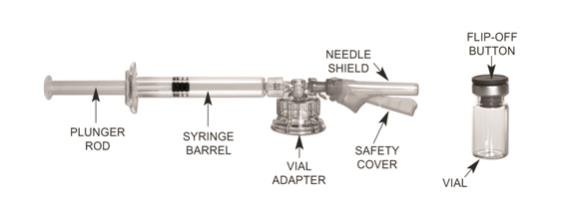
MIXJECT Preparation
Wash your hands with soap and hot water and put on gloves immediately prior to preparing the injection. Place the sealed tray on a clean, flat surface that is covered with a sterile pad or cloth. Peel the cover away from the tray and remove the MIXJECT components and the Trelstar vial. Remove the Flip-Off button from the top of the vial, revealing the rubber stopper. Place the vial in a standing upright position on the prepared surface. Disinfect the rubber stopper with the alcohol wipe. Discard the alcohol wipe and allow the stopper to dry. Proceed to MIXJECT Activation.
MIXJECT Activation
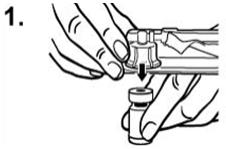
|
Peel the cover away from the blister pack containing the vial adapter. Do not remove the vial adapter from the blister pack. Place the blister pack containing the vial adapter firmly on the vial top, piercing the vial. Push down gently until you feel it snap in place. Remove the blister pack from the vial adapter. |
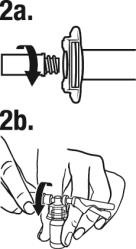
|
(a) Screw the plunger rod into the barrel end of the syringe. Remove the cap from the syringe barrel. (b) Connect the syringe to the vial adapter by screwing it clockwise into the opening on the side of the vial adapter. Be sure to gently twist the syringe until it stops turning to ensure a tight connection. |
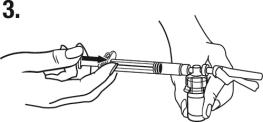
|
While holding the vial, place your thumb on the plunger rod and push the plunger rod in all the way to transfer the diluent from the pre-filled syringe into the vial. Do not release the plunger rod. |
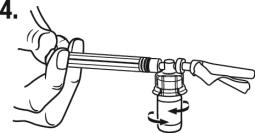
|
Keeping the plunger rod depressed, gently swirl the vial so that the diluent rinses the sides of the vial. This will ensure complete mixing of Trelstar and the sterile water diluent. The suspension will now have a milky appearance. In order to avoid separation of the suspension, proceed to the next steps without delay. |
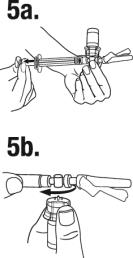
|
(a) Invert the MIXJECT system so that the vial is at the top. Grasp the MIXJECT system firmly by the syringe and pull back the plunger rod slowly to draw the reconstituted Trelstar into the syringe. (b) Return the vial to its upright position, and disconnect the vial adapter and vial from the MIXJECT syringe assembly by turning the plastic cap of the vial adapter clockwise. Grasp only the plastic cap when removing. |
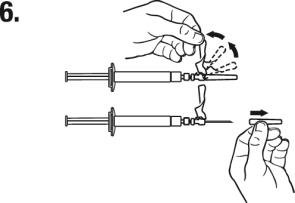
|
Lift up the safety cover and remove the clear plastic needle shield by pulling it from the assembly. The safety cover should be perpendicular to the needle, with the needle facing away from you. The syringe containing the Trelstar suspension is now ready for administration. The suspension should be administered immediately after reconstitution. |
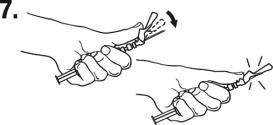
|
After administering the injection, immediately activate the safety mechanism by centering your thumb or forefinger on the textured finger pad area of the safety cover and pushing it forward over the needle until you hear or feel it lock. Use the one-handed technique and activate the mechanism away from yourself and others. Activation of the safety cover causes virtually no splatter. Immediately discard the syringe assembly after a single use into a suitable sharps container. |
Injectable suspension: 3.75 mg, 11.25 mg, 22.5 mg.
CONTRAINDICATIONS4.1 HypersensitivityTrelstar is contraindicated in individuals with a known hypersensitivity to triptorelin or any other component of the product, or other GnRH agonists or GnRH [see Warnings and Precautions (5.1)].
WARNINGS AND PRECAUTIONS5.1 Hypersensitivity ReactionsAnaphylactic shock, hypersensitivity, and angioedema related to triptorelin administration have been reported. In the event of a hypersensitivity reaction, therapy with Trelstar should be discontinued immediately and the appropriate supportive and symptomatic care should be administered.
5.2 Transient Increase in Serum TestosteroneInitially, triptorelin, like other GnRH agonists, causes a transient increase in serum testosterone levels. As a result, isolated cases of worsening of signs and symptoms of prostate cancer during the first weeks of treatment have been reported with GnRH agonists. Patients may experience worsening of symptoms or onset of new symptoms, including bone pain, neuropathy, hematuria, or urethral or bladder outlet obstruction [see Clinical Pharmacology (12.2)].
5.3 Metastatic Vertebral Lesions and Urinary Tract ObstructionCases of spinal cord compression, which may contribute to weakness or paralysis with or without fatal complications, have been reported with GnRH agonists. If spinal cord compression or renal impairment develops, standard treatment of these complications should be instituted, and in extreme cases an immediate orchiectomy considered.
Patients with metastatic vertebral lesions and/or with upper or lower urinary tract obstruction should be closely observed during the first few weeks of therapy.
5.4 Effect on QT/QTc IntervalAndrogen deprivation therapy may prolong the QT/QTc interval. Providers should consider whether the benefits of androgen deprivation therapy outweigh the potential risks in patients with congenital long QT syndrome, congestive heart failure, frequent electrolyte abnormalities, and in patients taking drugs known to prolong the QT interval. Electrolyte abnormalities should be corrected. Consider periodic monitoring of electrocardiograms and electrolytes.
5.5 Hyperglycemia and DiabetesHyperglycemia and an increased risk of developing diabetes have been reported in men receiving GnRH agonists. Hyperglycemia may represent development of diabetes mellitus or worsening of glycemic control in patients with diabetes. Monitor blood glucose and/or glycosylated hemoglobin (HbA1c) periodically in patients receiving a GnRH agonist and manage with current practice for treatment of hyperglycemia or diabetes.
5.6 Cardiovascular DiseasesIncreased risk of developing myocardial infarction, sudden cardiac death and stroke has been reported in association with use of GnRH agonists in men. The risk appears low based on the reported odds ratios, and should be evaluated carefully along with cardiovascular risk factors when determining a treatment for patients with prostate cancer. Patients receiving a GnRH agonist should be monitored for symptoms and signs suggestive of development of cardiovascular disease and be managed according to current clinical practice.
5.7 Laboratory TestsResponse to Trelstar should be monitored by measuring serum levels of testosterone periodically or as indicated.
5.8 Laboratory Test InteractionsChronic or continuous administration of triptorelin in therapeutic doses results in suppression of pituitary-gonadal axis. Diagnostic tests of the pituitary-gonadal function conducted during treatment and after cessation of therapy may therefore be misleading.
Based on findings from animal studies and mechanism of action, Trelstar can cause fetal harm when administered to a pregnant woman [Clinical Pharmacology (12.1)]. In animal developmental and reproductive toxicology studies, daily administration of triptorelin to pregnant rats during the period of organogenesis caused maternal toxicity and embryo-fetal toxicities, including loss of pregnancy, at doses as low as 0.2, 0.8, and 8 times the estimated human daily dose based on body surface area. Advise pregnant patients and females of reproductive potential of the potential risk to the fetus [see Use in Specific Populations (8.1)].
ADVERSE REACTIONS6.1 Clinical Trials ExperienceBecause clinical trials are conducted under widely varying conditions, adverse reaction rates observed in the clinical trials of a drug cannot be directly compared with rates in the clinical trials of another drug and may not reflect the rates observed in practice.
The safety of the three Trelstar formulations was evaluated in clinical trials involving patients with advanced prostate cancer. Mean testosterone levels increased above baseline during the first week following the initial injection, declining thereafter to baseline levels or below by the end of the second week of treatment. The transient increase in testosterone levels may be associated with temporary worsening of disease signs and symptoms, including bone pain, neuropathy, hematuria, and urethral or bladder outlet obstruction. Isolated cases of spinal cord compression with weakness or paralysis of the lower extremities have occurred [see Warnings and Precautions (5.3)].
Adverse reactions reported for each of the three Trelstar formulations in the clinical trials, are presented in Table 2, Table 3, and Table 4. Often, causality is difficult to assess in patients with metastatic prostate cancer. The majority of adverse reactions related to triptorelin are a result of its pharmacological action, i.e., the induced variation in serum testosterone levels, either an increase in testosterone at the initiation of treatment, or a decrease in testosterone once castration is achieved. Local reactions at the injection site or allergic reactions may occur.
The following adverse reactions were reported to have a possible or probable relationship to therapy as ascribed by the treating physician in at least 1% of patients receiving Trelstar 3.75 mg.
| Adverse Reactions* |
Trelstar 3.75 mg N = 140 |
|
| N | % | |
| Application Site Disorders | ||
| Injection site pain | 5 | 3.6 |
|
Body as a Whole |
||
| Hot flush | 82 | 58.6 |
| Pain | 3 | 2.1 |
| Leg pain | 3 | 2.1 |
| Fatigue | 3 | 2.1 |
|
Cardiovascular Disorders |
||
| Hypertension | 5 | 3.6 |
|
Central and Peripheral Nervous System Disorders |
||
| Headache | 7 | 5.0 |
| Dizziness | 2 | 1.4 |
|
Gastrointestinal Disorders |
||
| Diarrhea | 2 | 1.4 |
| Vomiting | 3 | 2.1 |
|
Musculoskeletal System Disorders |
||
| Skeletal pain | 17 | 12.1 |
|
Psychiatric Disorders |
||
| Insomnia | 3 | 2.1 |
| Impotence | 10 | 7.1 |
| Emotional lability | 2 | 1.4 |
|
Red Blood Cell Disorders |
||
| Anemia | 2 | 1.4 |
|
Skin and Appendages Disorders |
||
| Pruritus | 2 | 1.4 |
|
Urinary System Disorders |
||
| Urinary tract infection | 2 | 1.4 |
| Urinary retention | 2 | 1.4 |
* Adverse reactions for Trelstar 3.75 mg are coded using the WHO Adverse Reactions Terminology (WHOART)
The following adverse reactions were reported to have a possible or probable relationship to therapy as ascribed by the treating physician in at least 1% of patients receiving Trelstar 11.25 mg.
|
Adverse Reactions* |
Trelstar 11.25 mg N = 174 |
|
| N | % | |
|
Application Site |
||
| Injection site pain | 7 | 4.0 |
|
Body as a Whole |
||
| Hot flush | 127 | 73.0 |
| Leg pain | 9 | 5.2 |
| Pain | 6 | 3.4 |
| Back pain | 5 | 2.9 |
| Fatigue | 4 | 2.3 |
| Chest pain | 3 | 1.7 |
| Asthenia | 2 | 1.1 |
| Peripheral edema | 2 | 1.1 |
|
Cardiovascular Disorders |
||
| Hypertension | 7 | 4.0 |
| Dependent edema | 4 |
2.3 |
|
Central and Peripheral Nervous System Disorders |
||
| Headache | 12 | 6.9 |
| Dizziness | 5 | 2.9 |
| Leg cramps | 3 | 1.7 |
|
Endocrine |
||
| Breast pain | 4 | 2.3 |
| Gynecomastia | 3 | 1.7 |
|
Gastrointestinal Disorders |
||
| Nausea | 5 | 2.9 |
| Constipation | 3 | 1.7 |
| Dyspepsia | 3 | 1.7 |
| Diarrhea | 2 | 1.1 |
| Abdominal pain | 2 | 1.1 |
|
Liver and Biliary System |
||
| Abnormal hepatic function | 2 | 1.1 |
|
Metabolic and Nutritional Disorders |
||
| Edema in legs | 11 | 6.3 |
| Increased alkaline phosphatase | 3 | 1.7 |
|
Musculoskeletal System Disorders |
||
| Skeletal pain | 23 | 13.2 |
| Arthralgia | 4 | 2.3 |
| Myalgia | 2 | 1.1 |
|
Psychiatric Disorders |
||
| Decreased libido | 4 | 2.3 |
| Impotence | 4 | 2.3 |
| Insomnia | 3 | 1.7 |
| Anorexia | 3 | 1.7 |
|
Respiratory System Disorders |
||
| Coughing | 3 | 1.7 |
| Dyspnea | 2 | 1.1 |
| Pharyngitis | 2 | 1.1 |
|
Skin and Appendages |
||
| Rash | 3 | 1.7 |
|
Urinary System Disorders |
||
| Dysuria | 8 | 4.6 |
| Urinary retention | 2 | 1.1 |
|
Vision Disorders |
||
| Eye pain | 2 | 1.1 |
| Conjunctivitis | 2 | 1.1 |
* Adverse reactions for Trelstar 11.25 mg are coded using the WHO Adverse Reactions Terminology (WHOART)
The following adverse reactions occurred in at least 5% of patients receiving Trelstar 22.5 mg. The table includes all reactions whether or not they were ascribed to Trelstar by the treating physician. The table also includes the incidence of these adverse reactions that were considered by the treating physician to have a reasonable causal relationship or for which the relationship could not be assessed.
|
Adverse Reactions* |
Trelstar 22.5 mg N = 120 |
|||
| Treatment-Emergent | Treatment-Related | |||
| N | % | N | % | |
|
General Disorders and Administration Site Conditions |
||||
| Edema peripheral | 6 | 5.0 | 0 | 0 |
|
Infections and Infestations |
||||
| Influenza | 19 | 15.8 | 0 | 0 |
| Bronchitis | 6 | 5.0 | 0 | 0 |
|
Endocrine |
||||
| Diabetes Mellitus/Hyperglycemia | 6 | 5.0 | 0 | 0 |
|
Musculoskeletal and Connective Tissue Disorders |
||||
| Back pain | 13 | 10.8 | 1 | 0.8 |
| Arthralgia | 9 | 7.5 | 1 | 0.8 |
| Pain in extremity | 9 | 7.5 | 1 | 0.8 |
|
Nervous System Disorders |
||||
| Headache | 9 | 7.5 | 2 | 1.7 |
|
Psychiatric Disorders |
||||
| Insomnia | 6 | 5.0 | 1 | 0.8 |
|
Renal and Urinary Disorders |
||||
| Urinary tract infection | 14 | 11.6 | 0 | 0 |
| Urinary retention | 6 | 5.0 | 0 | 0 |
|
Reproductive System and Breast Disorders |
||||
| Erectile dysfunction | 12 | 10.0 | 12 | 10.0 |
| Testicular atrophy | 9 | 7.5 | 9 | 7.5 |
|
Vascular Disorders |
||||
| Hot flush | 87 | 72.5 | 86 | 71.7 |
| Hypertension | 17 | 14.2 | 1 | 0.8 |
* Adverse reactions for Trelstar 22.5 mg are coded using the Medical Dictionary for Regulatory Activities (MedDRA)
Changes in Laboratory Values During Treatment
The following abnormalities in laboratory values not present at baseline were observed in 10% or more of patients:
Trelstar 3.75 mg: There were no clinically meaningful changes in laboratory values detected during therapy.
Trelstar 11.25 mg: Decreased hemoglobin and RBC count and increased glucose, BUN, SGOT, SGPT, and alkaline phosphatase at the Day 253 visit.
Trelstar 22.5 mg: Decreased hemoglobin and increased glucose and hepatic transaminases were detected during the study. The majority of the changes were mild to moderate.
6.2 Postmarketing ExperienceThe following adverse reactions have been identified during post approval use of gonadotropin releasing hormone agonists. Because these reactions are reported voluntarily from a population of uncertain size, it is not always possible to reliably estimate their frequency or establish a causal relationship to drug exposure.
During postmarketing surveillance, rare cases of pituitary apoplexy (a clinical syndrome secondary to infarction of the pituitary gland) have been reported after the administration of gonadotropin-releasing hormone agonists. In a majority of these cases, a pituitary adenoma was diagnosed with a majority of pituitary apoplexy cases occurring within 2 weeks of the first dose, and some within the first hour. In these cases, pituitary apoplexy has presented as sudden headache, vomiting, visual changes, ophthalmoplegia, altered mental status, and sometimes cardiovascular collapse. Immediate medical attention has been required.
During postmarketing experience, convulsions, interstitial lung disease, and thromboembolic events including, but not limited to, pulmonary emboli, cerebrovascular accident, myocardial infarction, deep venous thrombosis, transient ischemic attack, and thrombophlebitis have been reported.
DRUG INTERACTIONSNo drug-drug interaction studies involving triptorelin have been conducted.
Human pharmacokinetic data with triptorelin suggest that C-terminal fragments produced by tissue degradation are either degraded completely within tissues or are rapidly degraded further in plasma, or cleared by the kidneys. Therefore, hepatic microsomal enzymes are unlikely to be involved in triptorelin metabolism. However, in the absence of relevant data and as a precaution, hyperprolactinemic drugs should not be used concomitantly with triptorelin since hyperprolactinemia reduces the number of pituitary GnRH receptors.
USE IN SPECIFIC POPULATIONS8.1 PregnancyRisk Summary
Based on findings in animal studies and mechanism of action, Trelstar can cause fetal harm when administered to a pregnant woman [see Clinical Pharmacology (12.1)]. Expected hormonal changes that occur with Trelstar treatment increase the risk for pregnancy loss. In animal developmental and reproductive toxicology studies, daily administration of triptorelin to pregnant rats during the period of organogenesis caused maternal toxicity and embryo-fetal toxicities, including loss of pregnancy, at doses as low as 0.2, 0.8, and 8 times the estimated human daily dose based on body surface area. Advise pregnant patients and females of reproductive potential of the potential risk to the fetus.
Data
Animal Data
Studies in pregnant rats administered triptorelin at doses of 2, 10, and 100 mcg/kg/day (approximately equivalent to 0.2, 0.8, and 8 times the estimated human daily dose based on body surface area) during the period of organogenesis demonstrated maternal toxicity and embryo-fetal toxicities. Embryo-fetal toxicities consisted of pre-implantation loss, increased resorption, and reduced mean number of viable fetuses at the high dose. Teratogenic effects were not observed in viable fetuses in rats or mice. Doses administered to mice were 2, 20, and 200 mcg/kg/day (approximately equivalent to 0.1, 0.7, and 7 times the estimated human daily dose based on body surface area).
8.2 LactationThe safety and efficacy of Trelstar have not been established in females. There are no data on the presence of triptorelin in human milk, the effects of the drug on milk production, or the effects of the drug on the breastfed child. Because of the potential for serious adverse reactions in a breastfed child from Trelstar, a decision should be made to either discontinue breastfeeding, or discontinue the drug taking into account the importance of the drug to the mother.
Infertility
Males
Based on mechanism of action, Trelstar may impair fertility in males of reproductive potential [see Clinical Pharmacology (12.1)].
8.4 Pediatric UseSafety and effectiveness in pediatric patients have not been established.
8.5 Geriatric UseProstate cancer occurs primarily in an older population. Clinical studies with Trelstar have been conducted primarily in patients ≥ 65 years [see Clinical Pharmacology (12.3) and Clinical Studies (14)].
8.6 Renal ImpairmentSubjects with renal impairment had higher exposure than young healthy males [see Clinical Pharmacology (12.3)].
8.7 Hepatic ImpairmentSubjects with hepatic impairment had higher exposure than young healthy males [see Clinical Pharmacology (12.3)].
OVERDOSAGEThere is no experience of overdosage in clinical trials. In single dose toxicity studies in mice and rats, the subcutaneous LD50 of triptorelin was 400 mg/kg in mice and 250 mg/kg in rats, approximately 500 and 600 times, respectively, the estimated monthly human dose based on body surface area. If overdosage occurs, therapy should be discontinued immediately and the appropriate supportive and symptomatic treatment administered.
DESCRIPTIONTrelstar is a white to slightly yellow lyophilized cake. When reconstituted, Trelstar has a milky appearance. It contains a pamoate salt of triptorelin, a synthetic decapeptide agonist analog of gonadotropin releasing hormone (GnRH). The chemical name of triptorelin pamoate is 5-oxo-L-prolyl-L-histidyl-L-tryptophyl-L-seryl-L-tyrosyl-D-tryptophyl-L-leucyl-L-arginyl-L-prolylglycine amide (pamoate salt). The empirical formula is C64H82N18O13 · C23H16O6 and the molecular weight is 1699.9. The structural formula is:
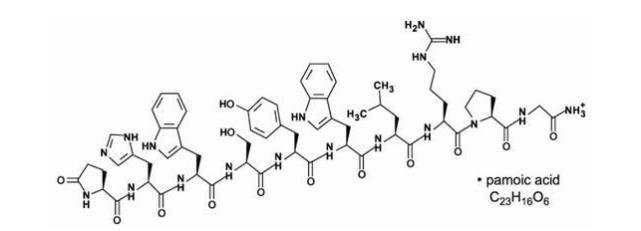
Structural formula for Trelstar (triptorelin pamoate).
The Trelstar products are sterile, lyophilized biodegradable microgranule formulations supplied as single dose vials. Refer to Table 5 for the composition of each Trelstar product.
|
Ingredients |
Trelstar 3.75 mg |
Trelstar 11.25 mg |
Trelstar 22.5 mg |
|
triptorelin pamoate (base units) |
3.75 mg | 11.25 mg | 22.5 mg |
|
poly-d,l-lactide-co-glycolide |
138 mg | 120 mg | 183 mg |
|
mannitol, USP |
71 mg | 74 mg | 74 mg |
|
carboxymethylcellulose sodium, USP |
25 mg | 26 mg | 26 mg |
|
polysorbate 80, NF |
1.7 mg | 1.7 mg | 1.7 mg |
When 2 mL sterile water is added to the vial containing Trelstar and mixed, a suspension is formed which is intended as an intramuscular injection. Trelstar is available in a vial plus a MIXJECT vial adapter, and a separate pre-filled syringe that contains sterile water for injection, USP, 2 mL, pH 6 to 8.5.
Triptorelin is a synthetic decapeptide agonist analog of gonadotropin releasing hormone (GnRH). Comparative in vitro studies showed that triptorelin was 100-fold more active than native GnRH in stimulating luteinizing hormone release from monolayers of dispersed rat pituitary cells in culture and 20-fold more active than native GnRH in displacing 125I-GnRH from pituitary receptor sites. In animal studies, triptorelin pamoate was found to have 13‑fold higher luteinizing hormone-releasing activity and 21-fold higher follicle-stimulating hormone-releasing activity compared to the native GnRH.
12.2 PharmacodynamicsFollowing the first administration, there is a transient surge in circulating levels of luteinizing hormone (LH), follicle-stimulating hormone (FSH), testosterone, and estradiol [see Adverse Reactions (6)]. After chronic and continuous administration, usually 2 to 4 weeks after initiation of therapy, a sustained decrease in LH and FSH secretion and marked reduction of testicular steroidogenesis are observed. A reduction of serum testosterone concentration to a level typically seen in surgically castrated men is obtained. Consequently, the result is that tissues and functions that depend on these hormones for maintenance become quiescent. These effects are usually reversible after cessation of therapy.
Following a single intramuscular injection of Trelstar:
Trelstar 3.75 mg: serum testosterone levels first increased, peaking on Day 4, and declined thereafter to low levels by Week 4 in healthy male volunteers.
Trelstar 11.25 mg: serum testosterone levels first increased, peaking on Days 2 – 3, and declined thereafter to low levels by Weeks 3 – 4 in men with advanced prostate cancer.
Trelstar 22.5 mg: serum testosterone levels first increased, peaking on Day 3, and declined thereafter to low levels by Weeks 3 – 4 in men with advanced prostate cancer.
12.3 PharmacokineticsResults of pharmacokinetic investigations conducted in healthy men indicate that after intravenous bolus administration, triptorelin is distributed and eliminated according to a 3-compartment model and corresponding half-lives are approximately 6 minutes, 45 minutes, and 3 hours.
Absorption
Following a single intramuscular injection of Trelstar to patients with prostate cancer, mean peak serum concentrations of 28.4 ng/mL, 38.5 ng/mL, and 44.1 ng/mL occurred in 1 to 3 hours after the 3.75 mg, 11.25 mg, and 22.5 mg formulations, respectively.
Triptorelin did not accumulate over 9 months (3.75 mg and 11.25 mg) or 12 months (22.5 mg) of treatment.
Distribution
The volume of distribution following a single intravenous bolus dose of 0.5 mg of triptorelin peptide was 30 – 33 L in healthy male volunteers. There is no evidence that triptorelin, at clinically relevant concentrations, binds to plasma proteins.
Elimination
Metabolism
The metabolism of triptorelin in humans is unknown, but is unlikely to involve hepatic microsomal enzymes (cytochrome P-450). The effect of triptorelin on the activity of other drug metabolizing enzymes is also unknown. Thus far, no metabolites of triptorelin have been identified. Pharmacokinetic data suggest that C-terminal fragments produced by tissue degradation are either completely degraded in the tissues, or rapidly degraded in plasma, or cleared by the kidneys.
Excretion
Triptorelin is eliminated by both the liver and the kidneys. Following intravenous administration of 0.5 mg triptorelin peptide to six healthy male volunteers with a creatinine clearance of 149.9 mL/min, 41.7% of the dose was excreted in urine as intact peptide with a total triptorelin clearance of 211.9 mL/min. This percentage increased to 62.3% in patients with liver disease who have a lower creatinine clearance (89.9 mL/min). It has also been observed that the nonrenal clearance of triptorelin (patient anuric, CIcreat = 0) was 76.2 mL/min, thus indicating that the nonrenal elimination of triptorelin is mainly dependent on the liver.
Special Populations
Age and Race
The effects of age and race on triptorelin pharmacokinetics have not been systematically studied. However, pharmacokinetic data obtained in young healthy male volunteers aged 20 to 22 years with an elevated creatinine clearance (approximately 150 mL/min) indicate that triptorelin was eliminated twice as fast in this young population as compared with patients with moderate renal insufficiency. This is related to the fact that triptorelin clearance is partly correlated to total creatinine clearance, which is well known to decrease with age [see Use in Specific Populations (8.6) and (8.7)].
Pediatric
Trelstar has not been evaluated in patients less than 18 years of age [see Use in Specific Populations (8.4)].
Hepatic and Renal Impairment
After an intravenous bolus injection of 0.5 mg triptorelin, the two distribution half-lives were unaffected by renal and hepatic impairment. However, renal insufficiency led to a decrease in total triptorelin clearance proportional to the decrease in creatinine clearance as well as increases in volume of distribution and consequently, an increase in elimination half-life (see Table 6). In subjects with hepatic insufficiency, a decrease in triptorelin clearance was more pronounced than that observed with renal insufficiency. Due to minimal increases in the volume of distribution, the elimination half-life in subjects with hepatic insufficiency was similar to subjects with renal insufficiency. Subjects with renal or hepatic impairment had 2‑ to 4-fold higher exposure (AUC values) than young healthy males [see Use in Specific Populations (8.6) and (8.7)].
|
Group |
Cmax (ng/mL) |
AUCinf (h·ng/mL) |
Clp (mL/min) |
Clrenal (mL/min) |
t1/2 (h) |
Clcreat (mL/min) |
|
6 healthy male volunteers |
48.2 ±11.8 |
36.1 ±5.8 |
211.9 ±31.6 |
90.6 ±35.3 |
2.81 ±1.21 |
149.9 ±7.3 |
|
6 males with moderate renal impairment |
45.6 ±20.5 |
69.9 ±24.6 |
120.0 ±45.0 |
23.3 ±17.6 |
6.56 ±1.25 |
39.7 ±22.5 |
|
6 males with severe renal impairment |
46.5 ±14.0 |
88.0 ±18.4 |
88.6 ±19.7 |
4.3 ±2.9 |
7.65 ±1.25 |
8.9 ±6.0 |
|
6 males with liver disease |
54.1 ±5.3 |
131.9 ±18.1 |
57.8 ±8.0 |
35.9 ±5.0 |
7.58 ±1.17 |
89.9 ±15.1 |
In rats, triptorelin doses of 120, 600, and 3000 mcg/kg given every 28 days (approximately 0.3, 2, and 8 times the human monthly dose based on body surface area) resulted in increased mortality with a drug treatment period of 13 – 19 months. The incidences of benign and malignant pituitary tumors and histiosarcomas were increased in a dose-related manner. No oncogenic effect was observed in mice administered triptorelin for 18 months at doses up to 6000 mcg/kg every 28 days (approximately 8 times the human monthly dose based on body surface area).
Mutagenicity studies performed with triptorelin using bacterial and mammalian systems (in vitro Ames test and chromosomal aberration test in CHO cells and an in vivo mouse micronucleus test) provided no evidence of mutagenic potential.
After 60 days of subcutaneous treatment followed by a minimum of four estrus cycles prior to mating, triptorelin, at doses of 2, 20, and 200 mcg/kg/day in saline (approximately 0.2, 2, and 16 times the estimated human daily dose based on body surface area) or 2 monthly injections as slow release microspheres (~20 mcg/kg/day), had no effect on the fertility or general reproductive function of female rats.
No studies were conducted to assess the effect of triptorelin on male fertility.
CLINICAL STUDIESTrelstar 3.75 mg
Trelstar 3.75 mg was studied in a randomized, active control trial of 277 men with advanced prostate cancer. The clinical trial population consisted of 59.9% Caucasian, 39.3% Black, and 0.8% Other. There was no difference observed with triptorelin response between racial groups. Men were between 47 and 89 years of age (mean = 71 years). Patients received either Trelstar 3.75 mg (N = 140) or an approved GnRH agonist monthly for 9 months. The primary efficacy endpoints were both achievement of castration by Day 29 and maintenance of castration from Day 57 through Day 253.
Castration levels of serum testosterone (≤ 1.735 nmol/L; equivalent to 50 ng/dL) in patients treated with Trelstar 3.75 mg were achieved at Day 29 in 125 of 137 (91.2%) patients and at Day 57 in 97.7% of patients. Maintenance of castration levels of serum testosterone from Day 57 through Day 253 was found in 96.2% of patients treated with Trelstar 3.75 mg.
The presence of an acute-on-chronic flare phenomenon was also studied as a secondary efficacy endpoint. Serum LH levels were measured at 2 hours after repeat Trelstar 3.75 mg administration on Days 85 and 169. One hundred twenty-four of the 126 evaluable patients (98.4%) on Day 85 had a serum LH level of ≤ 1.0 IU/L at 2 hours after dosing, indicating desensitization of the pituitary gonadotroph receptors.
Trelstar 11.25 mg
Trelstar 11.25 mg was studied in a randomized, active control trial of 346 men with advanced prostate cancer. The clinical trial population consisted of 48% Caucasian, 38% Black, and 15% Other. There was no difference observed with triptorelin response between racial groups. Men were between 45 and 96 years of age (mean = 71 years). Patients received either Trelstar 11.25 mg (N = 174) every 12 weeks for a total of up to 3 doses (maximum treatment period of 253 days) or Trelstar 3.75 mg (N = 172) every 28 days for a total of up to 9 doses. The primary efficacy endpoints were both achievement of castration by Day 29 and maintenance of castration from Day 57 through Day 253.
Castration levels of serum testosterone (≤ 1.735 nmol/L; equivalent to 50 ng/dL) were achieved at Day 29 in 167 of 171 (97.7%) patients treated with Trelstar 11.25 mg, and maintenance of castration levels of serum testosterone from Day 57 through Day 253 was found in 94.4% of patients treated with Trelstar 11.25 mg.
Trelstar 22.5 mg
Trelstar 22.5 mg was studied in a non-comparative trial of 120 men with advanced prostate cancer. The clinical trial population consisted of 64% Caucasian, 23% Black, and 13% Other, with a mean age of 71.1 years (range 51-93). Patients received Trelstar 22.5 mg (N = 120) every 24 weeks for a total of 2 doses (maximum treatment period of 337 days). The primary efficacy endpoints included achievement of castration by Day 29 and maintenance of castration from Day 57 through Day 337.
Castration levels of serum testosterone (≤ 1.735 nmol/L; equivalent to 50 ng/dL) were achieved at Day 29 in 97.5% (117 of 120) of patients treated with Trelstar 22.5 mg. Castration was maintained in 93.3% of patients in the period from Day 57 to Day 337.
A summary of the clinical studies for Trelstar is provided in Table 7.
|
Product Strength |
3.75 mg | 11.25 mg | 22.5 mg |
|
Number of Patients |
137 | 171 | 120 |
|
Treatment Schedule |
every 4 weeks | every 12 weeks | every 24 weeks |
|
Duration of Study |
253 days | 253 days | 337 days |
|
Castration Rate* on Day 29, % (n/N) |
91.2% (125/137) | 97.7% (167/171) | 97.5% (117/120) |
|
Rate of Castration Maintenance† from Days 57 – 253, % |
96.2% | 94.4% | not applicable |
|
Rate of Castration Maintenance from Days 57 – 337, % (n/N) |
not applicable | not applicable | 93.3% (112/120)‡ |
* Maintenance of castration was calculated using a frequency distribution.
† Cumulative maintenance of castration was calculated using a survival analysis (Kaplan-Meier) technique.
‡ Calculation includes 5 patients who discontinued the study but who had castrate levels of testosterone prior to discontinuation.
Trelstar is supplied in the Trelstar MIXJECT single-dose delivery system consisting of a vial with a Flip-Off seal containing sterile lyophilized triptorelin pamoate microgranules incorporated in a biodegradable copolymer of lactic and glycolic acids, a MIXJECT vial adapter, and a pre-filled syringe containing sterile water for injection, USP, 2 mL, pH 6 to 8.5.
Trelstar 3.75 mg –NDC 0023-5902-04 (Trelstar 3.75 mg with MIXJECT single-dose delivery system)
Trelstar 11.25 mg –NDC 0023-5904-12 (Trelstar 11.25 mg with MIXJECT single-dose delivery system)
Trelstar 22.5 mg –NDC 0023-5906-23 (Trelstar 22.5 mg with MIXJECT single-dose delivery system)
Storage
Store at 20-25°C (68-77°F). [See USP Controlled Room Temperature.] Do not freeze Trelstar with MIXJECT.
Hypersensitivity
Inform patients that if they have experienced hypersensitivity with other GnRH agonist drugs like Trelstar, Trelstar is contraindicated [see Contraindications (4)].Tumor Flare
Inform patients that Trelstar can cause tumor flare during the first weeks of treatment. Inform patients that the increase in testosterone can cause an increase in urinary symptoms or pain. Advise patients to contact their healthcare provider if uretral obstruction, spinal cord compression, paralysis, or new or worsened symptoms occur after beginning Trelstar treatment [see Warnings and Precautions (5.2)].Hyperglycemia and Diabetes
Advise patients that there is an increased risk of hyperglycemia and diabetes with Trelstar therapy. Inform patients that periodic monitoring for hyperglycemia and diabetes is required when being treated with Trelstar [see Warnings and Precautions (5.5)].Cardiovascular Disease
Inform patients that there is an increased risk of myocardial infarction, sudden cardiac death, and stroke with Trelstar treatment. Advise patients to immediately report signs and symptoms associated with these events to their healthcare provider for evaluation [see Warnings and Precautions (5.6)].Urogenital Disorders
Advise patients that Trelstar may cause impotence.Infertility
Inform patients that Trelstar may cause infertility [(see Use In Specific Populations (8.3)].Continuation of Trelstar Treatment
Inform patients that Trelstar is usually continued, often with additional medication, after the development of metastatic castration-resistant prostate cancer [see Dosage and Administration (2.1)].
For all medical inquiries contact:
Allergan
Medical Communications
1-800-678-1605
Distributed By:
Allergan USA, Inc.
Madison, NJ 07940
Manufactured By:
Debiopharm Research & Manufacturing SA
CH-1920 Martigny, Switzerland
MIXJECT is manufactured by:
West Pharma. Services IL, Ltd.
Ra'anana, Israel
The pre-filled syringe containing sterile water for injection is manufactured by:
Baxter Pharmaceutical Solutions, LLC
927 South Curry Pike
Bloomington, Indiana 47403
Trelstar® and its design are registered trademarks of Allergan Sales, LLC
MIXJECT® is a registered trademark of West Pharma. Services IL, Ltd.
© 2018 Allergan. All rights reserved.
v2.0USPI5902
PRINCIPAL DISPLAY PANEL
NDC 0023-5902-04
Trelstar 3.75 mg
3.75 mg every 4 weeks
Allergan
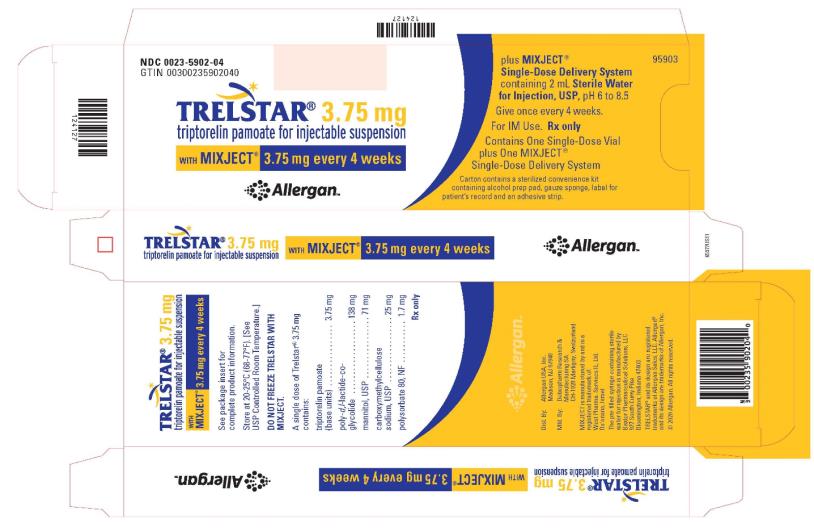
PRINCIPAL DISPLAY PANEL
NDC 0023-5904-12
Trelstar 11.25 mg
11.25 mg every 12 weeks
Allergan
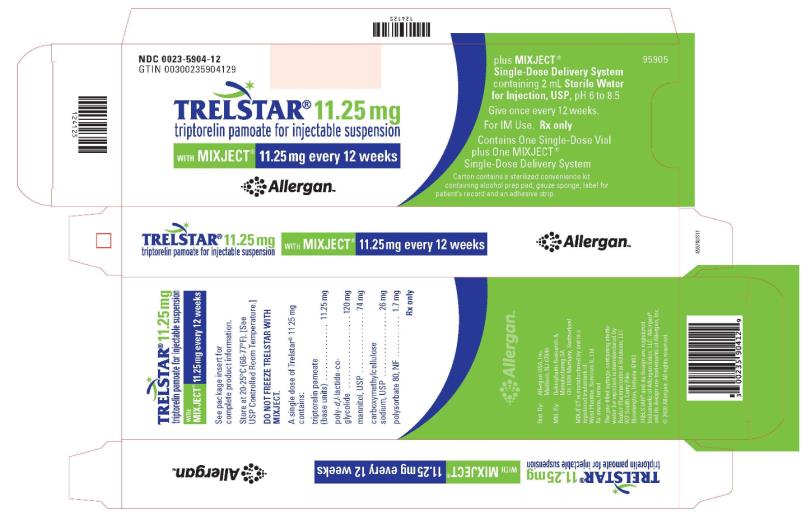
PRINCIPAL DISPLAY PANEL
NDC 0023-5906-23
Trelstar 22.5 mg
22.5 mg every 24 weeks
Allergan
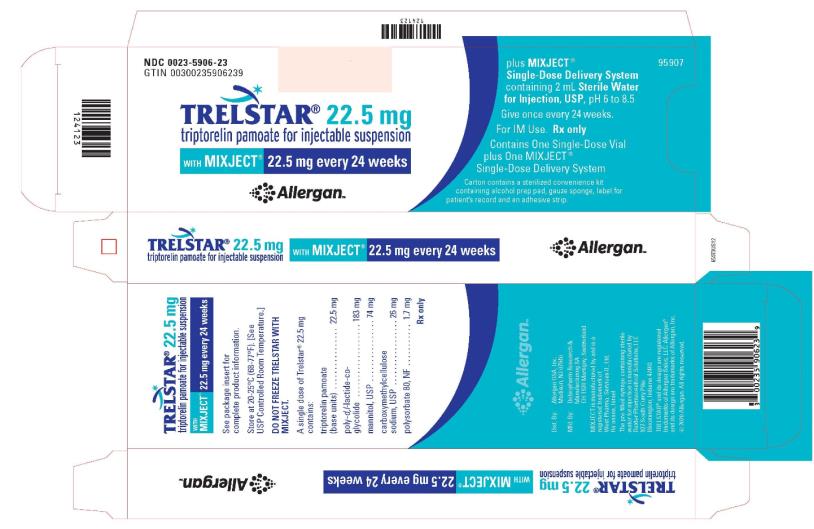
|
Trelstar triptorelin pamoate kit |
||||||||||||||
|
||||||||||||||
|
||||||||||||||
|
||||||||||||||
|
||||||||||||||
|
||||||||||||||
|
||||||||||||||
|
||||||||||||||
|
||||||||||||||
|
||||||||||||||
|
||||||||||||||
|
||||||||||||||
|
||||||||||||||
|
||||||||||||||
|
||||||||||||||
|
||||||||||||||
|
Trelstar triptorelin pamoate kit |
||||||||||||||
|
||||||||||||||
|
||||||||||||||
|
||||||||||||||
|
||||||||||||||
|
||||||||||||||
|
||||||||||||||
|
||||||||||||||
|
||||||||||||||
|
||||||||||||||
|
||||||||||||||
|
||||||||||||||
|
||||||||||||||
|
||||||||||||||
|
||||||||||||||
|
||||||||||||||
|
Trelstar triptorelin pamoate kit |
||||||||||||||
|
||||||||||||||
|
||||||||||||||
|
||||||||||||||
|
||||||||||||||
|
||||||||||||||
|
||||||||||||||
|
||||||||||||||
|
||||||||||||||
|
||||||||||||||
|
||||||||||||||
|
||||||||||||||
|
||||||||||||||
|
||||||||||||||
|
||||||||||||||
|
||||||||||||||
| Labeler - Allergan, Inc. (144796497) |